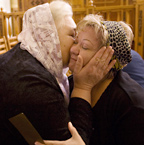Bible Studies for Life Series for January 7: Why am I here?
Posted: 12/29/06
Bible Studies for Life Series for January 7
Why am I here?
• Genesis 1:1-30
By Kenneth Lyle
Logsdon School of Theology, Abilene
With the New Year, we begin a new study theme, "Creation Faith: Living by God’s Design." This study focuses on the first eleven chapters of the book of Genesis, and posits several essential questions that speak to the heart of human existence. In week one, we ask “Why am I here?” The question points to the important issues of the origin and significance of human beings, our relationship to creation, and our purpose within creation. In week two, we will deal with sin, asking the question, “What’s the big problem?” In week three, the focus shifts to the value of human life. The question, “What is human life worth?” has far reaching implications that might surprise us. Finally, in week four we pose the question, “What hope for society?” This may be the most difficult and yet the most important question that faces God’s people. How does our hope become the world’s hope?
A recent Time magazine cover story highlighted a debate between Richard Dawkins, an atheist biologist, and Francis Collins, a Christian geneticist (Time, Nov. 13, 2006). In this “God vs. Science” debate, Dawkins and Collins engaged in a healthy discussion about the nature of faith and the reality of scientific progress. Time posed the question as to whether the two worldviews were compatible. While the two scientists did not come to a resolution of the issue, they demonstrated the importance and the possibility of a real conversation between religion and science.
Any study of Genesis 1-11 will provide opportunities for similar kinds of debate in the Sunday school classroom. These lessons, however, should not focus primarily on the debate between religion and science; rather, these lessons should help us examine our understanding of how God relates to creation and humanity. Genesis 1-11 presents a story about the origin of things: things like the sun, stars, moon, animals, plants, water, everything that “has been made” (John 1:3); things like sin, rebellion, hatred, and shame; things like redemption and rescue. In my view, Genesis 1-11 is less about science and more about God. That is not to say that there is no science in Genesis 1-11, but when we focus too much attention on the science, we diminish the more important theological dimension of the story.
Genesis 1-11 presents a view of the origin of the cosmos that was a direct refutation of several pagan cosmologies of the ancient world. Most of these pagan views of the origin of things focused on the roles of many gods who brought creation into place through personal conflict. The gods themselves would become the wind and the waves, the land and the sea. Genesis 1-11 presents a radically different understanding of how the one true God brings creation into existence from nothing and by nothing except the spoken word. God speaks, creation happens, God says that it is good.
The open verses of Genesis 1 begin the pattern that resounds throughout the first chapter. God creates the heaven and the earth out of nothing. At the heart of the biblical story of creation stands the assertion that God is not contingent. God has no beginning. God has no end. God calls creation into being, establishing and separating, assigning and delineating. Most importantly, God declares that creation is good. The pattern established in verses 1-4 continues through verse 25 and culminates with the creation of humans in verses 26-28. God’s assertion that creation is good resounds throughout the narrative; and should give us pause to reflect on how we as God’s people relate to creation in our own time.
In the second focal passage, our attention turns to the status and role of humans in the world. A portion of the text reads, “So God created man in his own image, in the image of God he created him; male and female he created them” (v. 27). These humans are to “fill the earth and subdue it” (v. 28); but the more significant assertion from these verses is that these created “things” are made in God’s own image. That God creates humanity in God’s images says something important about how much God loves us and how much we should love each other. In Victor Hugo’s Les Miserables, Jean Valjean learns from hard experience “the truth that once was spoken, ‘to love another person is to see the face of God.’” Because God makes us in God’s image, we must see each person as loveable—capable of receiving love. Far too often, we Christians retain the image of God for ourselves and forget that God stamps it on every human face.
The focal passage concludes with important words about God’s provision for humanity. God provides both sustenance and rest. God offers to these newly create humans a full plate of options for food while at the same time providing for the rest of creation (vv. 29-30). Most importantly, God provides humans with the opportunity for rest. God knows and appreciates that humans need rest. Jesus understood that Sabbath rest was given to humans for their benefit (Mark 2:27). The issue here is not whether we stay at home and take a nap after church, or whether stores should be open on Sunday. In a twenty-four hour a day, seven day a week world, where nothing stops—ever, God says to creation—take time to rest!
God is at the center of a biblical worldview: God who creates and sustains, God who provides sustenance and rest, God who loves and bids us to love. Why are we here? The answers are myriad, but it comes down to this: God calls us into being; God bids us to live and work in the world—to work for God’s purposes and find delight in them. At the heart of the Lord’s Prayer, Jesus crystallizes the essence of our purpose in the world. After offering appropriate praise to God, we are to ask for God’s kingdom to come; for God’s will to be done on earth as it is in heaven (Matthew 6:9-10). By God’s grace and power, we are here to make the creation everything God intends it to be.
Discussion Questions:
How do we talk about Genesis 1-11 without spending too much time on the religion vs. science debate? Is that the only significance of the Genesis 1-11 story?
Does the assertion that creation is “good” affect how we view our world, our environment, and our relationship to other people?
How do twenty-first century people find God’s rest in a 24/7 world?
In what ways can Christians help to bring about the hope of God’s will done on earth as it is in heaven?





